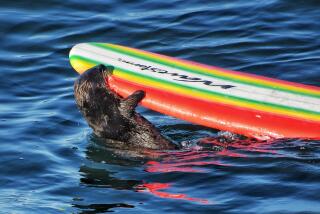Shrinking Numbers of Alaskan Otters Puzzle Scientists
- Share via
ANCHORAGE, Alaska — There is concern in Douglas Burn’s voice when he talks about the sea otters that frolicked and fed in reefs near Cold Bay just off the western end of the Alaska Peninsula.
“That place used to be lousy with sea otters,” he said. “To not see them there, clearly something is wrong.”
The sea otters of southwest Alaska are in trouble.
But exactly what is causing their populations to crash remains largely a mystery to wildlife biologists like Burn. They are alarmed at recent aerial surveys showing the dramatic decline in a huge area along Alaska’s coastline.
About 90% of the world’s sea otters live in coastal Alaska waters. Estimates put the number of sea otters in Alaska at 74,000--down from about 100,000 in the mid-1980s.
Biologists with the U. S. Fish and Wildlife Service already knew that sea otters in the 1,000-mile-long chain of islands, known as the Aleutian chain that extends from the Alaska Peninsula, had declined by about 70% since 1992.
Disturbing Signs From Above
New aerial surveys done in 2000 and 2001 to parallel a study done in 1986 have set off more alarm bells. They show that otter densities are low in the six major island groups of southwest Alaska, said Angela Doroff, a biologist.
Between 1986 and 2000, sea otters in the northern Alaska Peninsula declined between 36% and 56% to 5,756 animals. The decline was even more startling in the southern Alaska peninsula, where numbers between 1986 and 2001 declined at least 91% to just 1,844 sea otters.
Between 1994 and 2001, sea otters in the Kodiak archipelago declined 40% to 5,893 animals.
“We have no evidence that the decline is stopping,” said Rosa Meehan, head of Fish and Wildlife’s marine mammal program in Anchorage. “We had a red flag before. We have a much bigger red flag now.”
While sea otters in the southwest are declining sharply, populations in the southeast and the region known as southcentral appear to be either stable or increasing.
Biologists are considering a number of factors for the decline in the southwest, including starvation, disease and contamination. But predation by killer whales is the best guess, in part because biologists are finding so few carcasses.
Killer whales may be going after sea otters because there are fewer Steller sea lions to hunt, said Marilyn Dahlheim, a biologist with the National Marine Mammal Laboratory in Seattle, which is conducting a three-year study to count killer whales in an area of southwest Alaska.
Tracking Numbers of Killer Whales
During a six-week trip in July and August, biologists spotted 15 or 16 groups of killer whales. In 1992 and 1993, 12 groups of whales were spotted each year during similar trips.
“We really don’t have a good handle on population size,” Dahlheim said.
Scientists are taking skin samples to determine which whales are resident and which are transients. Resident whales feed primarily on fish, transients on marine mammals.
Other factors could be at work as well, Meehan said. Scientists are looking at climate changes, including El Nino, which causes an abnormal warming of ocean temperatures and tends to move warm air into western Canada and Alaska, creating fiercer storms.
Biologists will be taking a close look at the few places in southwest Alaska where sea otters are now concentrated. Those places include sheltered areas on the north and south sides of Adak Island, and Port Moller, Nelson Lagoon and Izembeck Lagoon on the north side of the Alaska peninsula.
It is important given the sharp decline in the southwest populations to keep tabs on the health of sea otters in other Alaska waters. They may be needed to repopulate areas now bereft of sea otters, Doroff said.
Alaska’s sea otters are capable of making dramatic comebacks. They were hunted nearly to extinction at the turn of the century, with numbers in the United States and Russia dwindling to about 2,000 before commercial hunting was banned in 1911.
Fish and Wildlife biologists in Anchorage want to include all of southwest Alaska’s sea otters as a candidate species for protection under the federal Endangered Species Act and plan to seek more funding to do so, Meehan said.
However, lawsuits from environmental groups seeking more protections are causing delays in getting sea otters and other species listed, Meehan said. That’s because Fish and Wildlife resources are tied up in meeting requirements set by judges in pending lawsuits, she said.
But the sea otters of southwest Alaska may not have a lot of time. They are “going downhill fast,” Burn said.
In the meantime, biologists hope to conduct more aerial and boat surveys and talk with locals in southwest Alaska to get their observations. They also want to hold a workshop with experts to discuss other possible sources of mortality or stress, including commercial fishing and development.
More to Read
Sign up for Essential California
The most important California stories and recommendations in your inbox every morning.
You may occasionally receive promotional content from the Los Angeles Times.












